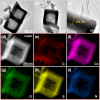Hollow Porous CoO@Reduced Graphene Oxide Self-Supporting Flexible Membrane for High Performance Lithium-Ion Storage
- PMID: 37446503
- PMCID: PMC10343264
- DOI: 10.3390/nano13131986
Hollow Porous CoO@Reduced Graphene Oxide Self-Supporting Flexible Membrane for High Performance Lithium-Ion Storage
Abstract
We report an environment-friendly preparation method of rGO-based flexible self-supporting membrane electrodes, combining Co-MOF with graphene oxide and quickly preparing a hollow CoO@rGO flexible self-supporting membrane composite with a porous structure. This unique hollow porous structure can shorten the ion transport path and provide more active sites for lithium ions. The high conductivity of reduced graphene oxide further facilitates the rapid charge transfer and provides sufficient buffer space for the hollow Co-MOF nanocubes during the charging process. We evaluated its electrochemical performance in a coin cell, which showed good rate capability and cycling stability. The CoO@rGO flexible electrode maintains a high specific capacity of 1103 mAh g-1 after 600 cycles at 1.0 A g-1. The high capacity of prepared material is attributed to the synergistic effect of the hollow porous structure and the 3D reduced graphene oxide network. This would be considered a promising new strategy for synthesizing hollow porous-structured rGO-based self-supported flexible electrodes.
Keywords: CoO@rGO; MOF; flexible electrodes; graphene; hollow structure; lithium-ion batteries; ultrafast integration.
Conflict of interest statement
The authors declare that they have no known competing financial interests or personal relationships that could have appeared to influence the work reported in this paper.
Figures






Similar articles
-
Consecutive engineering of anodic graphene supported cobalt monoxide composite and cathodic nanosized lithium cobalt oxide materials with improved lithium-ion storage performances.J Colloid Interface Sci. 2023 Dec 15;652(Pt B):2017-2028. doi: 10.1016/j.jcis.2023.09.025. Epub 2023 Sep 9. J Colloid Interface Sci. 2023. PMID: 37696056
-
Size-controllable synthesis of Zn2GeO4 hollow rods supported on reduced graphene oxide as high-capacity anode for lithium-ion batteries.J Colloid Interface Sci. 2021 May;589:13-24. doi: 10.1016/j.jcis.2020.12.121. Epub 2021 Jan 2. J Colloid Interface Sci. 2021. PMID: 33450456
-
CuCo2O4 Hollow Microspheres with Graphene Composite Targeting Superior Lithium-Ion Storage.Langmuir. 2021 Jul 20;37(28):8426-8434. doi: 10.1021/acs.langmuir.1c00670. Epub 2021 Jul 7. Langmuir. 2021. PMID: 34233119
-
Boosting Lithium Storage Properties of MOF Derivatives through a Wet-Spinning Assembled Fiber Strategy.Chemistry. 2018 Sep 18;24(52):13792-13799. doi: 10.1002/chem.201802826. Epub 2018 Aug 31. Chemistry. 2018. PMID: 29992663
-
Three-Dimensional Hierarchical Constructs of MOF-on-Reduced Graphene Oxide for Lithium-Sulfur Batteries.Chem Asian J. 2019 Oct 15;14(20):3577-3582. doi: 10.1002/asia.201900848. Epub 2019 Aug 23. Chem Asian J. 2019. PMID: 31407470
Cited by
-
N-Octadecane Encapsulated by Assembled BN/GO Aerogels for Highly Improved Thermal Conductivity and Energy Storage Capacity.Nanomaterials (Basel). 2023 Aug 12;13(16):2317. doi: 10.3390/nano13162317. Nanomaterials (Basel). 2023. PMID: 37630901 Free PMC article.
-
Nanostructured Electrodes for High-Performance Supercapacitors and Batteries.Nanomaterials (Basel). 2023 Oct 23;13(20):2807. doi: 10.3390/nano13202807. Nanomaterials (Basel). 2023. PMID: 37887957 Free PMC article.
References
-
- Tu C., Peng A., Zhang Z., Qi X., Zhang D., Wang M., Huang Y., Yang Z. Surface-Seeding Secondary Growth for CoO@Co9S8 P-N Heterojunction Hollow Nanocube Encapsulated into Graphene as Superior Anode toward Lithium Ion Storage. Chem. Eng. J. 2021;425:130648. doi: 10.1016/j.cej.2021.130648. - DOI
-
- Guan X., Nai J., Zhang Y., Wang P., Yang J., Zheng L., Zhang J., Guo L. CoO Hollow Cube/Reduced Graphene Oxide Composites with Enhanced Lithium Storage Capability. Chem. Mater. 2014;26:5958–5964. doi: 10.1021/cm502690u. - DOI
LinkOut - more resources
Full Text Sources

